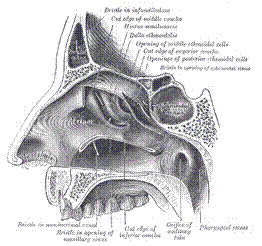Nose Terms
Everyone knows what noses are for, right? Maybe not. Noses are actually responsible for at least six important jobs: breathing, smelling, speaking, capturing foreign particles and preventing them from entering the body through the airway, and warming cold or frigid outside air prior to taking it into the lungs. And last, but not least…the nose plays a critical part in facial appearance! The shape, size and placement of your nose is responsible for family resemblance, level of masculinity or femininity, and cultural perception of attractive appearance.
Obviously, craniofacial differences during development can greatly affect the nose, and possibly change all of that. But don’t let those details intimidate you. The more you learn, the more confident you’ll be in encouraging your child as we discuss and carry out related corrections.

Alar Cartilage
Refers to the flexible, firm material inside your child’s nose that holds the upper portion of the nostrils open and symmetrical;
the cartilage extends from the tip of the nose across the top of each nostril.
Columella
Refers to the skin connecting the tip of the nose to the base of the face, separating the nostrils.
Maxillary Sinuses
The soft, triangular structures under the cheeks, on either side of the nose; these help your child smell and prevent germs from entering the body by entrapping them in mucous which your child can then blow out and eliminate.
Nasal Emission or Nasal Escape
Refers to an abnormal air flow which leaves the nose while the person speaks; typically this tells us that there is an opening or gap in the normal seal between the mouth and inner nose areas.
Nasal Floor
Refers to the area above and connected to the hard palate, which is normally closed off from the inner mouth area.
Nasal Septum
Refers to the thin vertical plane of cartilage dividing the two sides of the nose; extending from the back of
the nose up to its tip in the shape of an upside-down 7; this is the structure which gives the nose its specific
height perpendicular to the face’s plane of space.
Nasoalveolar molding
Refers to the pre-surgical shaping of the lip, dental ridge, and nostrils which decreases the extent of clefting.
Nasopharyngeal airway
Refers to the nose’s airway created when we place a small tube into the nose and down into the airway; this prevents airway closure.
Nostril
Refers to the two openings of the nose through which your child can breathe and smell; also includes the skin and cartilage which form the openings.
Tip
Refers to the skin and tissue forming the very end of your child’s nose.